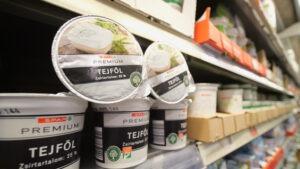After margin freeze: sour cream prices continue to fall
More than a month has passed since the government introduced a margin freeze on thirty products, including dairy products. In the case of sour cream, the price drop was particularly spectacular: prices fell by an average of 24.4 percent in the first week, but the correction has continued since then, the Portfolio article points out.
 Before the measure was introduced, Minister of National Economy Márton Nagy highlighted in a Facebook video that extremely high margins of up to 128 percent were observed on sour cream. The first data partially supported this: the price of some sour creams decreased by more than 50 percent, while smaller price reductions of 15–26 percent were registered for other products, mainly at discount chains.
Before the measure was introduced, Minister of National Economy Márton Nagy highlighted in a Facebook video that extremely high margins of up to 128 percent were observed on sour cream. The first data partially supported this: the price of some sour creams decreased by more than 50 percent, while smaller price reductions of 15–26 percent were registered for other products, mainly at discount chains.
Following the price cut on March 24, the price of sour creams decreased on average first by 0.2 percent, and then by another 2.8 percent a week later. A smaller price increase of 1.1 percent followed until April 11, but by April 22, prices had decreased by another 1.2 percent. Based on price monitoring data, the average price of sour cream remained permanently lower than before the margin freeze.
The prices of some products remained stable after the initial decrease. For example, the price of “A Tejes” lactose-free sour cream at 282 forints did not change in Auchan over a month. The prices of other sour creams continued to decrease after the margin freeze: for example, the price of “Auchan Kedvenc” lactose-free sour cream decreased from 242 forints to 209 forints.
In the case of branded products, a more hectic price development was observed. For example, the price of “Riska” 300-gram lactose-free sour cream fell from 1,099 forints to 556 forints, and then fluctuated in several waves between 550 and 750 forints. The price movement of “Mizo” sour cream was even more extreme: the 330-gram package fell from 959 forints to 549 forints, then fluctuated between extreme values between 476 and 674 forints.
According to experience, the prices of private-label sour creams were more stable, while larger fluctuations were more frequent for branded products, probably in line with promotions and market strategies.
The price decrease particularly strongly affected lactose-free sour creams, which were previously more expensive than traditional products. Fat content did not show a clear correlation with price changes.
Related news
The Hungarian Confederation of Economic Workers also spoke out regarding the inflation data
🎧 Hallgasd a cikket: Lejátszás Szünet Folytatás Leállítás Nyelv: Auto…
Read more >K&H: what does child inflation show?
🎧 Hallgasd a cikket: Lejátszás Szünet Folytatás Leállítás Nyelv: Auto…
Read more >The forint may remain relatively strong, even permanently
🎧 Hallgasd a cikket: Lejátszás Szünet Folytatás Leállítás Nyelv: Auto…
Read more >Related news
The Temu model is at a turning point: extra-cheap online imports may become more expensive from 2026
🎧 Hallgasd a cikket: Lejátszás Szünet Folytatás Leállítás Nyelv: Auto…
Read more >Climate-tolerant alternative in arable fields: peanuts could be one of the winners of climate change
🎧 Hallgasd a cikket: Lejátszás Szünet Folytatás Leállítás Nyelv: Auto…
Read more >Experience, timing, awareness: a new travel logic is emerging towards 2026
🎧 Hallgasd a cikket: Lejátszás Szünet Folytatás Leállítás Nyelv: Auto…
Read more >






